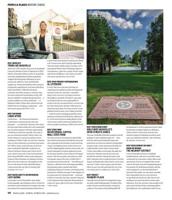
“Picasso Figure Library Painting,” Jonathan Edelhuber
In this postmodern age of art production, we see lots of art about art. Mountains of meta-minded paintings, videos and sculptures offer reflexive images, sounds and forms that point back at their own mediums, materials, styles and influences. Like it or not, art about art is practically de rigueur in today’s gallery scene, where no matter the subject of the work, the “What’s it mean?” content — in one way or another — is often about art itself. Creating something shiny and new in such an overly saturated space can often mean finding a fresh approach, and for Contemporary Art History — currently on view at Channel to Channel — that includes injecting a much-needed dose of irreverence into content that’s all too often overly self-serious and painfully intellectualized.
Contemporary Art History manages to present an engaging, vibrant and playful display of art about art by simultaneously aiming high and diving low, and expressing its investigations of the art of our times in bold graphic styles, comic-book-inspired renderings and a popping palette of toy-store tones. This two-person show includes paintings and sculpture from Nashville-based artist Jonathan Edelhuber and José Lerma, who splits his time between Chicago and San Juan, Puerto Rico. Both of these artists revel in utilizing low popular culture to take the haughty hot air out of historical, high fine-art culture. They both bring their own takes and styles to these objectives, and the result is a small but scintillating display that feels complete and of a piece.
Edelhuber’s work makes up the bulk of the display in Contemporary Art History. The artist’s colorful paintings and sculptures are bookish investigations of contemporary art history, and the work will prove especially delicious to gallery-goers who might have something like an addiction to big, beautiful, inky-smelling coffee table art tomes. Both Edelhuber’s paintings and sculptures share similar structures, picturing a recognizable element from a well-known contemporary artist’s work that’s perched atop a stack of contemporary art books — the spines face the viewer so the titles, artists’, authors’ and publishers’ names can all be read. These aren’t exactly painstaking reproductions, but they’re all modeled on the designs of actual books. Edelhuber refers to these book-centric works as “library” paintings and sculptures, and while they all repeat the same structure, their looks and their art-historical contexts are unique.

“Keith Haring Library Painting,” Jonathan Edelhuber
“Keith Haring Library Painting” pictures one of the 1980s street-artist-turned-gallery-star’s iconic dancing-dog images. The drawings inside the outline of the dog capture a dog riding on a man, a man being bitten on the foot by a dog, and even a dog walking a man on a leash. The dog is dancing on a stack of books about artists Sam Moyer, Richard Prince and Cy Twombly. Twombly’s use of text and textual gestures made an impact on both Haring and his pal Jean-Michel Basquiat. Haring even dedicated his 1988 painting of a yellow hand outlined in purple, “Untitled (For Cy Twombly),” to the painter. Prince was one of Haring’s peers in the 1980s New York art scene, and along with artists like David Salle and Cindy Sherman, made up the so-called Pictures Generation, which brought representational imagery and mass-media references into the art aesthetics of the Reagan era. Haring died in 1990 when Moyer was only 7 years old. Her paintings incorporate materials like stone, marble and bronze to marry both painting and sculpture while also connecting her contemporary art to ancient history and archaeology. Haring’s energized doodles borrowed from ancient sources like European cave paintings and Egyptian hieroglyphics. The puzzle-like art history lessons that Edelhuber’s works convey offer knowledgeable deep dives that pair perfectly against his works’ playful chromatic surfaces.

“Portrait IV,” José Lerma
José Lerma’s suite of black-and-white portraits offers a complementary contrast to Edelhuber’s playful and colorful works. Lerma works a lot with portraiture, subverting the traditional idea that a painted portrait is supposed to be a very serious work of art that celebrates and mythologizes a very important person. Lerma renders his anonymous subjects with thick black lines, pairing voluptuous forms with grid-like textures. The multi-eyed and distorted faces nod to Cubism while also making a mockery of monstrous elites. There’s even something a little Haring-like in Lerma’s work that reads as simultaneously offhand and precise. There’s also a graphic print-like quality to the look of these portraits, which complements Edelhuber’s comic-book-inspired takes on iconic art works.

“Portrait V,” José Lerma
For better or worse, postmodernism has bridged the boundaries and flattened the playing field that once divided high and low art. The best contemporary artists understand how to combine various cultural expressions into displays that highlight the high points of high culture without letting it get too far up its own institutional orifices. We want smart art but not elitist, snobby art. We want entertaining art, but not merely amusing art. In the 21st century, we visit art galleries for serious fun, and this month, serious fun is at Channel to Channel.








